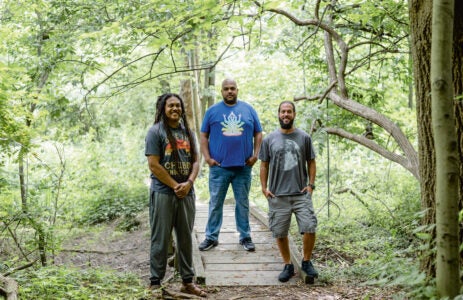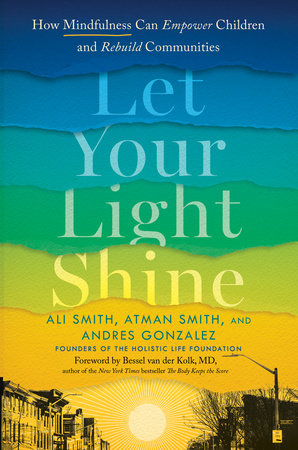 In this inspiring book, founders of The Holistic Life Foundation Ali Smith, Atman Smith, and Andres Gonzalez describe how they have spent the past twenty years teaching yoga, meditation, and breathwork to thousands of at-risk kids in Baltimore schools helping them to develop deep reserves of patience, empathy, resolve, and—when needed—the righteous anger that fuels deep structural change. Their work has received wide national attention due to their remarkable results: The schools that have participated in their programs have seen suspension rates plummet and graduation rates go through the roof.
In this inspiring book, founders of The Holistic Life Foundation Ali Smith, Atman Smith, and Andres Gonzalez describe how they have spent the past twenty years teaching yoga, meditation, and breathwork to thousands of at-risk kids in Baltimore schools helping them to develop deep reserves of patience, empathy, resolve, and—when needed—the righteous anger that fuels deep structural change. Their work has received wide national attention due to their remarkable results: The schools that have participated in their programs have seen suspension rates plummet and graduation rates go through the roof.
The Child’s Brain on Stress
All kids are stressed, but poor kids are stressed to the very limit. Poverty-related stress (a variation of chronic psychosocial stress) is about more than money. It’s the accumulation of every other fear and anxiety that these kids deal with on a day-to-day basis. It could be a relative who’s crashing on their couch and who says or does things that feel weird, inappropriate, or seriously traumatizing, while the kid’s actual parents are away at work all waking hours. Maybe their parents are out of work or on reduced hours and can’t make rent this month. There’s no food in the fridge and no one has money to buy more. The guys on the block are harassing them, but so are the police. Or more likely, it’s all those things and more, combined.
These kids perceive threats to their well-being but also know they don’t have the resources to deal with them. So the brain jumps in with a fight-or-flight response, flooding a kid’s body with cortisol, epinephrine, and dopamine. These hormones serve their purpose in the short term: They might give a kid that burst of energy and aggressiveness and the appearance of confidence that he or she needs to rebuff that relative, or walk by those guys on the block, ignoring their comments. Cortisol improves the body’s function, allowing it to access more energy to fight or flee. In the long term, however, repeated floods of cortisol suppress the body’s immune system. Eventually as our kids grow up, they are more susceptible to heart disease, diabetes, and other illnesses. The stress is literally killing them.
Adolescent Brain Function
Most of our kids have multiple adverse childhood experiences, or ACEs. ACEs are traumatic events that happen in a child’s life and adversely affect their ability to function and develop the way a non-traumatized person does. Research has shown that most people in Baltimore have three or more ACEs.
Eventually these repeated ACEs affect the brain, shrinking the hippocampus (where we process our emotions, consolidate short-term memories into long-term memories, and manage stress). As a result, the brain doesn’t develop fully, and the child, already running on fumes from the daily stress of his or her life, is now struggling with self-regulation, fear processing, decision-making, and stress management. These kids are the ones acting out or flat-out not showing up for school. But, as a colleague pointed out to us early in our work with him, “the kids who are acting up in class, causing problems, and being confrontational with the teacher are often the kids who want that teacher’s attention the most. That teacher might be the one link—either strong or weak—that that kid has in their life. And they are getting that teacher’s attention in the only way they know how.”
The Traumatized Brain
Neurologically there is a huge difference between a typical brain and a traumatized brain. The traumatized brain doesn’t have access to higher functions. It is pretty much living in survival mode. People who have been traumatized become caught in a state of sympathetic dominance (or fight or flight). Their cortisol levels are really high and lead to problems like weight gain, diabetes, and ulcers. Increased levels of adrenaline lead to increased blood pressure. Executive function (basically the mental skills that we use on a daily basis to go about our lives, like self-control, time management, organization, etc.), located in the prefrontal cortex, is less accessible to people who have been highly traumatized. That means increased impulsivity, loss of emotional control, and decreased self-awareness.
So when you see people—such as our youth—acting out, you need to understand that a lot of those issues you might call bad behavior or anger issues aren’t really those kinds of issues. Instead, they are the signs of deep-rooted, multigenerational trauma popping up and taking control of a person’s brain.
Trauma also affects the vagus nerve, which is the means of communication between the brain and the body. When people are severely traumatized, their vagus nerve no longer fires properly. They literally lose the ability to interpret the signals their body is trying to send to and receive from the brain.
The severely traumatized also have out-of-whack threat perception: They see everything as a threat, grossly overreacting to small problems, snubs, or angry interactions that non-traumatized people (if they exist) can process and move on from quickly. Studies have shown that ACEs can be passed on through generations, and that children who experience abuse are more likely to abuse when they become parents.
A traumatized brain in Baltimore can look like kids who are fighting over nothing. That is part of that fight-or-flight trauma. An innocent bump is seen as a threat, and that fight or flight kicks in. You can be in a classroom, thinking everything is going well, when suddenly a kid jumps out of his seat and runs. Why? You have no idea. The kid most likely has no idea either.
Trauma can sound underwhelming. We’ve all experienced bad stuff that messes with our heads. What’s different is the intensity and repercussions of trauma in our communities. Nearly everyone who has come up in Baltimore over the last few decades has PTSD from their trauma. They flinch, just like soldiers, at sudden, unexpected noises. They self-medicate.
Worse, there are almost no resources available to these traumatized people. It would take a state or federal initiative to get mental health care to everyone in Baltimore who needs it, and we all know that ain’t coming anytime soon.
Healing the Traumatized Brain
The body receives a constant stream of messages through the skin, the muscles, and the joints and sends them to the brain. For a non-or lightly traumatized person, these messages are benign, even pleasant. But for severely traumatized people, that message their brain is getting is fear and the possibility of danger around every corner.
This is why yoga and mindfulness work for traumatized children: When you do practices like yoga it puts you in the present moment. You feel safe. You’re caught up in the moment and that fear is not being registered or sent to your brain. It’s crucial to understand potential triggers that can shatter this feeling of safety. For a sexually or physically abused child a physical adjustment can feel like a shocking violation. An instruction to close their eyes can take them straight back to being assaulted. Never assume your experiences are universal—you have no idea what the child or adult sitting in front of you has survived.
After you work with the body, then you can start working with the mind. A lot of teachers want to put people in silent meditation, but the silence allows the trauma to come up. What we do is guided imagery and meditations. You get stillness, but it’s a full stillness, where people can start to understand what inner peace can become.
We work with people to develop their inner resources. Help them make their body a safe space, and then help them find inner peace because that’s something no one can ever take away from them! If you can help them get to a peaceful place, no matter how chaotic their life is, it is something they will always have, and can turn to in those moments of stress or trauma.






